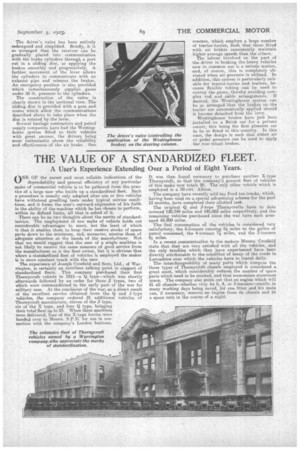THE VALUE OF A STANDARDIZED FLEET.
Page 13

If you've noticed an error in this article please click here to report it so we can fix it.
A User's Experience Extending Over a Period of Eight Years.
ONE OF the surest and most reliable indications of the dependability and general efficiency of any particular make of commercial vehicle is to be gathered from the practice of a large user who builds up a standardized fleet. Such a procedure is usually only adapted after one or two vehicles have withstood gruelling tests under typical service conditions, and it forms the user's outward expression of his faith in the ability of the machine which he has chosen to perform, within its defined limits, all that is asked of it. There can be no two thoughts about the merits of standardization. The employment of one make of vehicle holds out considerable advantages to users, not the least of -which is that it enables them to keep their reserve stocks of spare parts down to the minimum, and, moreover, assures them of adequate attention at. the hands of the manufacturer. Not that we would suggest that the user of a single machine is not likely to receive the same measure of good service from the manufacturer as is the fleet owner, but it is obvious that where a standardized fleet of vehicles is employed the maker is in more constant touch with the user. The experience of Joseph Crosfield and Sons, Ltd., otf Warrington, is certainly an excellent talking point in support of standardized fleets. This company purchased their first Thornycroft vehicle in 1915—a Q type—which was shortly afterwards followed by an order for three J types, two of which were commandeered in the early part of the war for military uses. At the conclusion of the war, as a. direct result of the excellent service obtained from the Q and J-type vehicles, the company ordered 21 additional vehicles of Thornycroft manufacture, eleven of the J type, six of the X type, and four Q type, bringing
their total fleet up to 23. When these machines were delivered, four of the X-type lorries were handed over to Messrs..S.P.D. for use in connection with the company's London business. It was then found .necessary to purchase another X-type Thornycroft, so that the company's present fleet of vehicles of this make now totals 20. The only other vehicle which is employed is a 50-cwt. Albion.
The company have recently sold ten Ford ton trucks, which, having been used on a special advertising scheme for the past 12 months, have completed their allottdtask. The original Q and J-type Thornycrofts have to date covezed 130,749 miles and 146,083 miles respectively, and the remaining vehicles purchased since the war have each averaged 43,930 miles. The fuel consumption of the vehicles is considered very satisfactory, the 5-totiners running 5imiles to the gallon of petrol consumed, the 4-tonners 4 miles, and the 3-tonners miles. In a recent communication to the makers Messrs. Crosfield state that they are very satisfied with all the vehicles, and the only troubles which they have experienced have been directly attributable to the condition of many of the roads in Lancashire over which the vehicles have to travel daily. The interchangeability of many parts which compose the three types of Thornycroft chassis employed is considered a great asset, which considerably reduces_ the number of spare parts which need to he stocked, and thus economizes storeroom space. The company also point out that an engine which will fit all chassis—whether they be 5, 4, or 3-tanners—results in many working days being saved, for one fitter and his mate can, if necessary, remove an engine from its chassis and fit a spare unit in the course of a night.




























